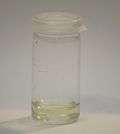Isoprene, or 2-methyl-1,3-butadiene, is a common volatile organic compound with the formula CH2=C(CH3)−CH=CH2. In its pure form it is a colorless volatile...
18 KB (1,841 words) - 17:33, 3 November 2024
Terpene (redirect from Isoprene rule)
solids. Conceptually derived from isoprenes, the structures and formulas of terpenes follow the biogenetic isoprene rule or the C5 rule, as described...
32 KB (3,489 words) - 20:15, 26 October 2024
naturally occurring organic chemicals derived from the 5-carbon compound isoprene and its derivatives called terpenes, diterpenes, etc. While sometimes used...
11 KB (913 words) - 19:44, 24 October 2024
The enzyme isoprene synthase (EC 4.2.3.27) catalyzes the chemical reaction prenyl pyrophosphate ⇌ {\displaystyle \rightleftharpoons } isoprene + diphosphate...
4 KB (479 words) - 14:37, 26 August 2023
which are terpenoids (isoprenoids), synthesized biochemically from eight isoprene units and thus having 40 carbons. Dietary β-carotene is a provitamin A...
34 KB (3,541 words) - 22:37, 9 October 2024
caoutchouc, as initially produced, consists of polymers of the organic compound isoprene, with minor impurities of other organic compounds. Thailand, Malaysia,...
61 KB (7,078 words) - 11:49, 2 November 2024
without decomposition, although at elevated temperatures it cracks to form isoprene. It oxidizes easily in moist air to produce carveol, carvone, and limonene...
19 KB (1,534 words) - 01:33, 11 November 2024
Triterpenes are a class of terpenes composed of six isoprene units with the molecular formula C30H48; they may also be thought of as consisting of three...
5 KB (509 words) - 14:51, 30 April 2023
of isoprene. In practice polyisoprene is commonly used to refer to synthetic cis-1,4-polyisoprene, made by the industrial polymerisation of isoprene. Natural...
5 KB (502 words) - 19:27, 10 July 2024






